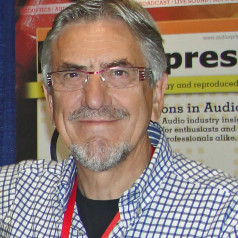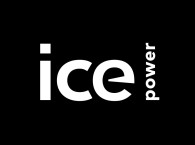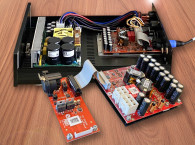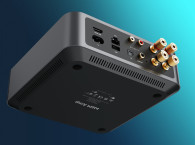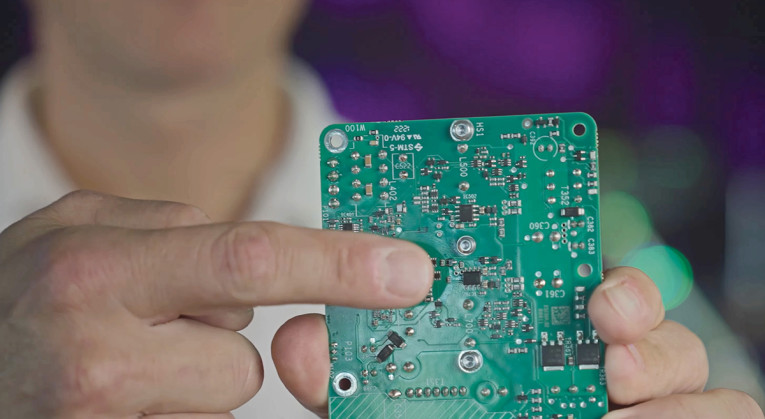
Many audioXpress readers will remember the days that ICEpower became the Class-D branch of Bang & Olufsen (B&O). The story goes that, in 1999, Karsten Nielsen founded a joint venture with Bang & Olufsen based on the results, patents, and inventions developed through his Ph.D work at the Technical University of Denmark. This earlier work and developments directly supported by Bang & Olufsen resulted in the launch of the company’s first commercial product — the A series, in 2001. The company was renamed Bang & Olufsen ICEpower and worked with Sanyo Semiconductor to manufacture discrete electronic devices, later leading to a partnership with Samsung Telecommunications for the successful development of dedicated amplifiers for mobile phones.
Rapid growth led to expansion into high-end niche markets, and ICEpower products were embraced by prestigious audio brands. This was followed by expansion into the automotive market, supplying audio amplifier solutions for brands such as Audi, Mercedes, Aston Martin, and BMW. At the other end of the scale, ICEpower expanded into the OEM business for everything from pro audio to laptops. In 2008, Karsten Nielsen exited the company and sold his shares, making it a wholly owned subsidiary of Bang & Olufsen.
Although quite successful for the following years, the management team felt that the expansion and innovation opportunities for ICEpower were constrained as a “Class-D division” of B&O. That lead to a management buyout in 2016.
Keld Lindegaard Andersen, CEO, and Mads Emil Solgaard, VP, Sales & Marketing, together with private equity fund Industri Udvikling acquired the business from Bang & Olufsen, becoming ICEpower A/S, with a clear mission to consolidate its position as a leader in Class-D audio.
Four months later, they announced the decision to merge with Audio Bricks, and to acquire its holding company, Bolecano Holding AB, from Sweden. The move was strategic to bring Patrik Boström and Lars Press Petersen, who had founded that venture in 2014, back to the company. Audio Bricks also gave ICEpower access to patents and IP from Anaview, a former competitor founded by Patrik Boström. Both had cooperated with the company earlier. Petersen held the position of Innovation Manager at ICEpower from 2003-2008, and Boström worked there as contractor in the beginning of his career, before Anaview. Boström and Petersen became ICEpower shareholders, holding the position of CTO, Amplification, and CTO, Research and SMPS, respectively.
In October 2023, the company entered a new growth stage, when Crestline Investors, headquartered in Fort Worth, TX, acquired a majority stake in the company. The investment will provide ICEpower’s management the means to accelerate the company’s global growth strategy as a “preferred partner for outsourced product creation to the leaders of the audio industry.”
Under Andersen’s leadership since the separation from Bang & Olufsen, ICEpower has transformed to become a leading design house and trusted partner to global audio brands within the professional and high-end segments of the audio industry (Photo 1).

In the last five years alone, the company has enjoyed stellar double-digit revenue growth and expansion from 15 to more than 100 engineers. Now, ICEpower takes complete ownership of the product development and operations value chain, with direct operations across Denmark, Europe, Thailand, Japan, and the US.
Standing Out
Apparently, in 2024, designing superior Class-D audio amplifier modules is no longer enough. To be successful, a company must distinguish itself from the competition. High performance, reliability, and low return rate products are necessary but not enough. You need to reassure your prospective customers that your products are not only the best fit but support their efforts to ensure they deliver the intended results in the finished product.
For starters, you must address a very important issue for any customer: support. You can buy many different amplifier modules from many manufacturers, but if you don’t support product development, the integration experience will suffer, and results likely underwhelm. That’s why ICEpower presents itself as a turnkey solution provider, supporting all aspects of product creation.
Even after creating a product, ICEpower supports long lifecycles, often up to 20 years, and guarantees availability over that period, working actively to develop long-term relationships based on that premise. And by supporting their customers’ journey for the long term, ICEpower also learns from the experience.
“We expect continued growth in areas like professional audio, home automation, and commercial installations from the hospitality industry to large-scale events. By the way, when we say home automation, we specifically mean automation and management of audio reproduction in a residential setup with different zones and uses. That also includes increased adoption of streaming and control over IP. This automatically leads to more ’intelligence’ built into many of our products,” explained Global Marketing Director Anders Laybourn (Photo 2), when I asked him about their market outlook. And by the way, I learned from him that the I in “ICEpower” stands for Intelligent, C for Compact, and E for Efficient.

Two specific developments convinced the company’s management that ICEpower should be positioned as a turnkey solution provider to the industry, as Anders detailed. “We see large companies moving from product providers to ecosystem and solution companies. And it becomes increasingly difficult for audio companies to do everything themselves. Partnering and sourcing technical expertise becomes increasingly important. ICEpower wants to be that preferred technical partner in all aspects of product creation and realization. That is our vision: to become the preferred partner for outsourced audio product creation to the leaders in the audio industry.”
What I found surprising was to learn that turnkey solutions already account for about 60% of ICEpower’s business. Meaning that less than 40% are from volume sales of just the amplifier modules, of which a very small percentage are unit sales for the do-it-yourself market. “You would be surprised at our presence inside many high-end audio products and even in your favorite guitar amplifier! Our customers do not advertise that, with very few exceptions. We understand, and respect that,” Laybourn tells me.
Turnkey ICEpower
To offer complete turnkey solutions to audio companies means having to understand the myriad aspects of their product functionalities and system architecture. This may start with the analog signal and a power supply design but, depending on the product, almost always includes software and user interface functionality, digital audio circuits, DSP, and audio over IP. And all that must be packaged, requiring mechanical design.
The final product needs an attractive enclosure, and ICEpower employs more than a dozen mechanical design engineers to optimize this stage of the project. Simulation, prototyping, and “Design for Manufacturability” are important steps in this phase; all in close coordination with the customer.
I discussed this with Sales and Marketing Director Mads Emil Solgaard (Photo 3), who explained how they handle every customer as a self-contained project.
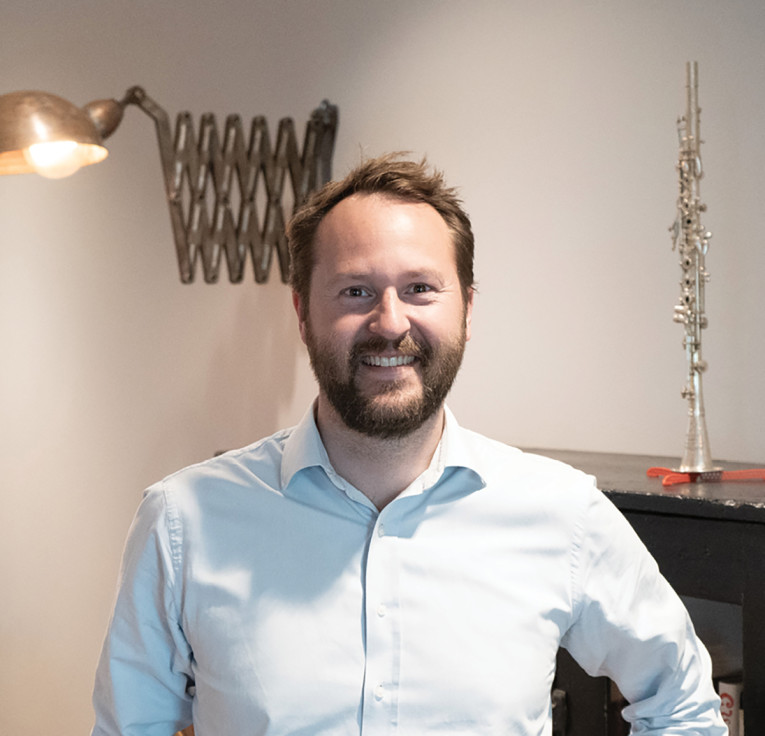
“ICEpower does a full range of analog small signal and power amplification to Class-D amplification, up to 6kW modules. We also do special amplifiers for applications like mobile phones where the output can have three values instead of two in standard Class-D. Those amplifiers do not need output filters.”
The software aspect of a product is also becoming increasingly important and ICEpower employs 30 software engineers just for that. “We design everything from user interfaces and dedicated product websites to embedded firmware for various platforms, down to the low-level drivers and bootloaders. Our design capability includes Windows, Linux, FreeRTOS operating systems as well as several streaming and control protocols like Dante, Milan, AES67/70. But our team will also design according to a customer’s proprietary protocol,” Emil Solgaard shared.
On the hardware side, ICEpower has full design and engineering capabilities for both analog and digital, as well as mixed signal design. The company’s low noise and extremely linear and transparent audio signal path designs are complemented by ICEpower’s traditional switch mode amplifier and power supply technology. Designs are completed from initial ideas and advanced simulation through PCB design, board verification, and testing. They will even design and build the production line test equipment, which some customers require. In all stages of the development, the focus is on providing maximum signal transparency with minimal power consumption.
Over the course of several years, ICEpower established this position as an Outsourced Product Creation Partner. Something that is not always visible to the outside world, due to the confidentiality agreements that prevent them from disclosing specific names—which naturally include elite brands in the pro audio, hifi, residential audio, and commercial installation markets. Products, including very high-end home stereo and home theater analog input and digital/streaming amplifiers, to 16-channel amplifiers and up to 4kW per channel output power amplifiers for live touring and fixed installation.
“We even designed amplifiers for the US Navy for sonar applications, and for medical equipment like large MRI scanners. It’s hard to get away from us!” Emil Solgaard adds.
Of course, there are still those customers who want to roll their own, and ICEpower offers a rich palette of off-the-shelf amplifier and power supply modules, plus chipsets in various combinations. As with a turnkey product, close collaboration with customers involve full access to documentation, certificates, and guidelines for the whole range (Figure 1).

“We have our own manufacturing facilities in Thailand, conforming to the same rigorous quality standards as our design, engineering, and support facilities here in Denmark. We design all our products here in Denmark, including magnetic parts like transformers and inductors.
We go quite far to make ourselves self-sufficient, in order to support our customers over long periods of time. As an example, with multichannel products you often need many switching channels and normally you’d use mechanical small-signal relays, which can be very good. But we found it hard to find the right parts from different manufacturers, so we looked into solid-state switches. Some are even more transparent than relays but those are very expensive and single source. With the inspiration from a circuit by Douglas Self, we developed our own circuit, designed an IC that implemented it, and applied for a patent,” Emil Solgaard tells me.
“We also have been building our expertise in mechanical design to enable us to deliver turnkey products. We do mechanical simulation, thermal design, airflow analysis, everything that’s required for reliable and robust and affordable mechanical design, and we can manufacture and test prototypes right here in our facility. We see ourselves more as a service company than a product company. It’s not: here’s the datasheet, and good luck with your design — no, we engage with our customers and help them to design their products.”
With so many areas requiring attention, can ICEpower get enough qualified staff for the company’s needs? “So far, we can; we are located in a high-tech area and the talent is there. I should also mention that we offer internships to students from our Technical University here, and we do our best to keep them on afterwards. So far, it’s working,” confirms Solgaard.

ICEpower@Manhattan
ICEpower believes that to create inspiring solutions, people need inspiring surroundings. ICEpower is located in Søborg, a Copenhagen suburb. The first thing you encounter when entering the premises is a stage with a ready-to-play set of guitars and bass and a large drum kit! That sets the stage (no pun intended) for the whole area of offices, labs, and workshops. The place is infused with music (Photo 4). Several offices sport high-end stereo systems, sometimes including a record player and a stack of LPs. One conference room is dedicated to David Bowie, including a bookcase of books recommended by Bowie (Photo 5). All rooms have names that come from areas in Manhattan, a story that the company’s website (refreshed in 2023) explains in detail [1].
The company implemented what they refer to as ICEpower@Manhattan. The approximately 2500m2 office space, departments, and competencies are organized to match the layout of Manhattan (Figure 2). This means there’s an Uptown, a Mid-town, and a Downtown. Up-town and Mid-town are centered around sales, marketing, finance, and operations, and have several meeting facilities, including the Live Stage, Music Library, Discotheque, listening room, and kitchen facilities. In Downtown, we move into the heart of the audio creation processes involving approximately 75 engineers


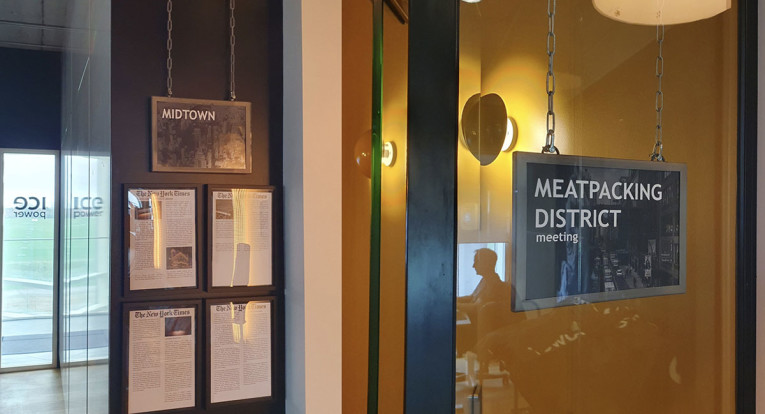
It was there that I got to spend a few pleasant hours with Patrik Boström (Photo 7), talking about all things technical. We discussed one thing I had on my mind, which was the attention recently given to digital feedback in Class-D (and other) amplifiers. The idea appears attractive: If you have digital capability in the feedback loop, it becomes easier to tailor the loop transfer function to your requirements. With feedback taken after the customary output L-C filter with its phase shifts, and the need for high-order feedback to get low distortion and low output impedance over the entire audio band, this is an important factor. Of course, you need a very fast A-D converter in that digital feedback loop, but these have recently become available.
Patrik Boström isn’t convinced. The top section in Figure 3 shows an overall chain with analog feedback; the bottom section shows the loop modified for digital feedback. “What you see is that you have traded an audio-bandwidth D-A conversion in the forward loop for a high bandwidth A-D conversion in the feedback loop. It is not at all clear which solution will be best overall. For now, we use analog feedback which gives us the performance figures that leave us nothing to wish for.”
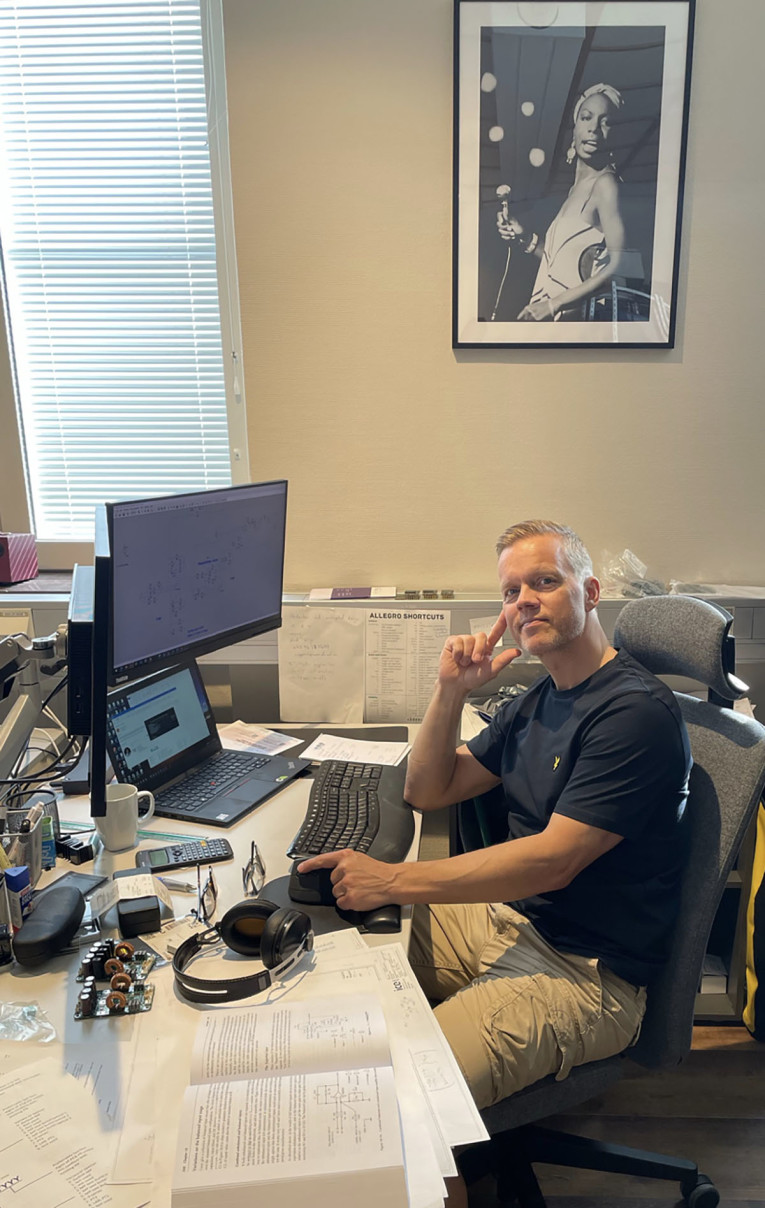
And as Boström reminded me Class-D switching amplifiers already have a 50-year history. A very early patent was obtained by Clayton Sturgeon (Figure 4), which already shows the basic setup for UcD Class-D [2]. It wasn’t called Class-D, and in fact that name is unfortunate—people still associate the “D” in Class-D with digital, but of course a Class-D amplifier processes analog voltage, current, and time. But that’s water under the bridge and our conversation quickly evolved to areas that ICEpower is investigating.
“Another hot item in Class-D and SMPS these days is the use of GaN devices instead of the traditional MOSFETs. The conflict is in balancing switching frequency with distortion. The output filter inductor makes the amplifier self-commute at idle, so you normally set the dead time for that in order to minimize idle consumption. With traditional MOSFETs and the intrinsic body diode, which acts as a freewheel diode, this works well but GaN devices are so very fast that the dead time would have to be varied between idle and high output current to maintain self-commuting at idle while also keeping high-order harmonics in check. These arise with GaN because the reverse conduction voltage is so much higher at about 3V to 4V compared to about 1V for MOSFETs. Of course, you can use a discrete high-voltage, high current Schottky but that pretty much kills any cost advantage for GaN. There are also some practical issues due to the fact that GaN devices are so tiny, it is much harder to find a good way to accurately sense their temperature for protection and current limit purposes. So, although it is a promising technology, which we will follow, we don’t see it as a mainstream product yet,” Boström shared.
In traditional home hifi circles there is sometimes an almost religious reservation about Class-D performance, but in the professional and install business Class-D is fully accepted for the very high performance it delivers with low cost and high efficiency.
“We do of course a lot of analog design and development where we often have proprietary or patented methods where we routinely get down to -120dB or -130dB distortion levels. But even our Class-D products have distortion levels much lower than almost any Class (A)B analog amp ever made, even better than the legendary Halcro’s. Class-D often has flat loop gain over frequency so has less rise of distortion with frequency. Our latest SC300A2 module can hold its own against any analog or switching amplifier out there.” (See Figures 5–7).
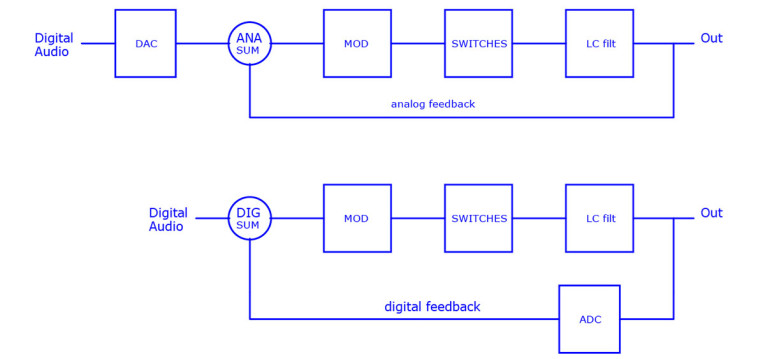
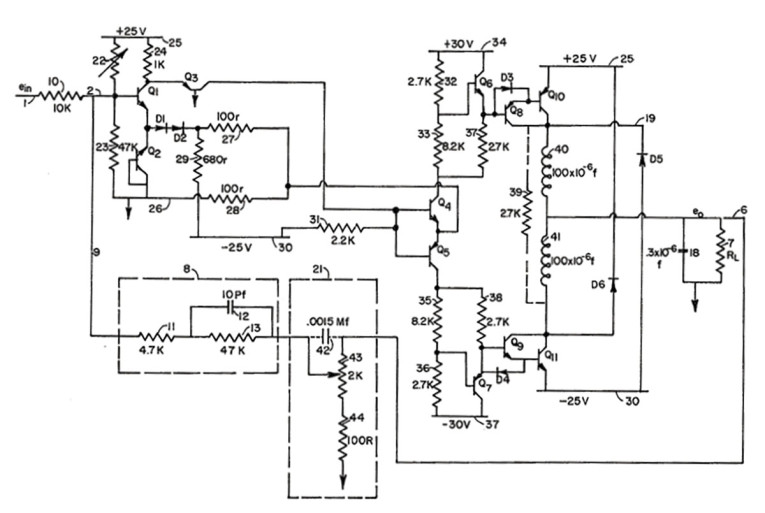
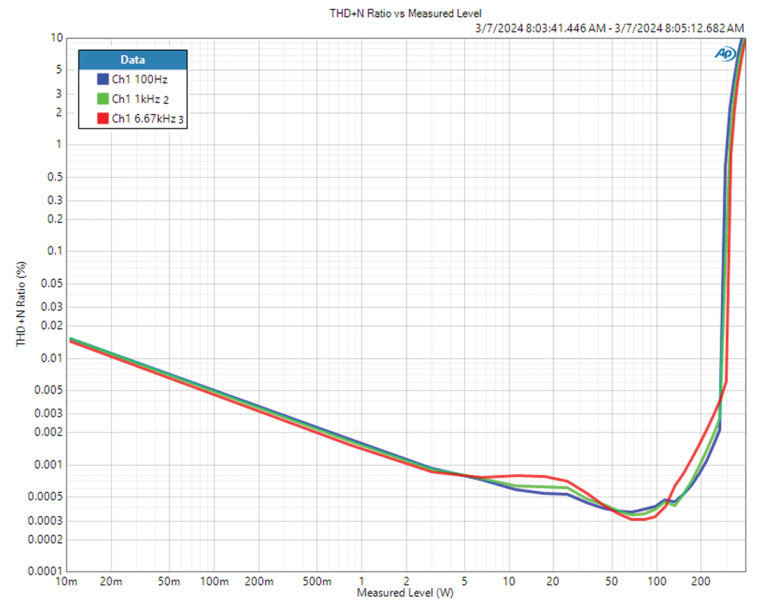
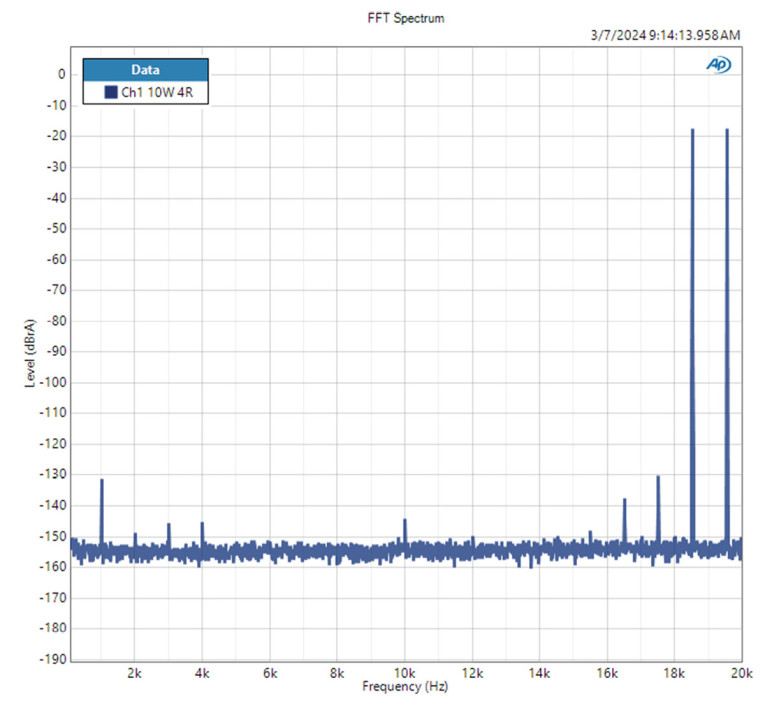
f1 = 18.5kHz, f2 = 19.5kHz.

As Boström explains, in professional audio applications, priorities are very different. An area of focus for ICEpower is in providing reliability and ways to remotely supervise large professional audio systems. Suppose you have a large outdoor system for the Super Bowl, and there’s a system error with only 10 seconds to fix it. It is extremely important to quickly identify the area and individual unit that is at fault. “Even something as simple as the capability to remotely power cycle a unit is very valuable, because as we all know, power cycling fixes 50% of the problems! So that is something we increasingly incorporate in our products.”
“We are also developing Class-D amplifiers that can deliver 100Vrms output to drive hi-Z systems but also able to drive 4Ω loads. Such amplifiers can be configured by the user, which involves configuring the power supply voltage for the intended use so that in both configurations the efficiency is maximized. You can even use one channel of a dual amplifier to drive 4Ω and the other to drive a 100Vrms system, with somewhat reduced efficiency,” he discloses.
“Let’s talk about another issue: current-limiting the MOSFET output currents. Available gate drivers sense the voltage across the MOSFET, which when conducting is Rds(on) of course, and use that voltage as input to the current limiting circuit. This is lossless, no separate shunts are needed. The problem here is that when that MOSFET heats up, its Rds(on) drops. Also, there’s production spread in the MOSFETs so their Rds(on) varies up to 15% anyway. So it’s inaccurate. We stopped using these gate drivers and developed our own device, the ICC5, and an external current limiting circuit. That circuit uses very small shunts with very small losses and is quite accurate. It is hysteresis-based, which allowed us to add a refinement: When the current limits, a different loop takes over and instead of a self-oscillating voltage loop, the amplifier becomes a current amplifier. The nice thing here is that it always clips as if it is a voltage amplifier, no matter at which point of the output swing the current limiting occurs! This is important because with current limiting your pulse width drops dramatically and there’s a big step in the output, which sounds ugly. With the new circuit, that step doesn’t happen and this sounds much more like soft clipping and is less disturbing. We filed a patent for this circuit.”
This is the development that let ICEpower to recently unveil ICC5, the latest addition to its lineup of audio power solutions. “The ICC5 allows us to tailor the drive circuit for a wide range of applications and power ranges; it’s a simple, low-cost device in an 8-pin case (Photo 8) (we actually use one pin for multiple functions). We are not a semiconductor house of course but we will supply the chip to customers if the situation warrants it.”

And, finally, Boström shared the company’s newest research into fixed oscillation frequency Class-D amplifiers. “In multichannel amplifiers, there is a chance that different oscillation frequencies (for instance, due to different loading) causes beat frequencies in the audio band. You can’t synchronize the amplifiers in a box because that only works at idle. So, we’re looking into a way to run our modules at a fixed frequency,” he disclosed.
In Closing
My visit ended with some interesting discussions about the origins of feedback control and stability in World War II, when scientists such as Henrik Bode and Harry Nyquist were drafted from Bell Labs. Their task: to solve the problem of slewing Navy air defense guns fast and with no lag or overshoot so they could shoot down those new, agile attacking fighters! Which, of course, has everything to do with Class-D amplifiers! But that’s for another day. ICEpower has a lot of exciting technologies under development, which means we will be back soon. aX
References
[1] ICEpower@Manhattan, ICEpower, https://icepoweraudio.com/our-office/#Get_Started
[2] C. L. Sturgeon “Linear amplifier utilizing transistor switching,” CA1042079A, granted November 1978, https://patents.google.com/patent/CA1042079A/en
This article was originally published in audioXpress, July 2024


